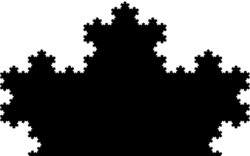
Back Selbstähnlichkeit ALS تشابه ذاتي Arabic Sejbstähnlichkeit BAR Самоподобие Bulgarian Soběpodobnost Czech Пайьевĕрлĕх CV Selvsimilær Danish Selbstähnlichkeit German Αυτοομοιότητα Greek Autosimilitud Spanish


In mathematics, a self-similar object is exactly or approximately similar to a part of itself (i.e., the whole has the same shape as one or more of the parts). Many objects in the real world, such as coastlines, are statistically self-similar: parts of them show the same statistical properties at many scales.[2] Self-similarity is a typical property of fractals. Scale invariance is an exact form of self-similarity where at any magnification there is a smaller piece of the object that is similar to the whole. For instance, a side of the Koch snowflake is both symmetrical and scale-invariant; it can be continually magnified 3x without changing shape. The non-trivial similarity evident in fractals is distinguished by their fine structure, or detail on arbitrarily small scales. As a counterexample, whereas any portion of a straight line may resemble the whole, further detail is not revealed.
Peitgen et al. explain the concept as such:
If parts of a figure are small replicas of the whole, then the figure is called self-similar....A figure is strictly self-similar if the figure can be decomposed into parts which are exact replicas of the whole. Any arbitrary part contains an exact replica of the whole figure.[3]
Since mathematically, a fractal may show self-similarity under arbitrary magnification, it is impossible to recreate this physically. Peitgen et al. suggest studying self-similarity using approximations:
In order to give an operational meaning to the property of self-similarity, we are necessarily restricted to dealing with finite approximations of the limit figure. This is done using the method which we will call box self-similarity where measurements are made on finite stages of the figure using grids of various sizes.[4]
This vocabulary was introduced by Benoit Mandelbrot in 1964.[5]
- ^ Mandelbrot, Benoit B. (1982). The Fractal Geometry of Nature, p.44. ISBN 978-0716711865.
- ^ Mandelbrot, Benoit B. (5 May 1967). "How long is the coast of Britain? Statistical self-similarity and fractional dimension". Science. New Series. 156 (3775): 636–638. Bibcode:1967Sci...156..636M. doi:10.1126/science.156.3775.636. PMID 17837158. S2CID 15662830. Archived from the original on 19 October 2021. Retrieved 12 November 2020. PDF
- ^ Peitgen, Heinz-Otto; Jürgens, Hartmut; Saupe, Dietmar; Maletsky, Evan; Perciante, Terry; and Yunker, Lee (1991). Fractals for the Classroom: Strategic Activities Volume One, p.21. Springer-Verlag, New York. ISBN 0-387-97346-X and ISBN 3-540-97346-X.
- ^ Peitgen, et al (1991), p.2-3.
- ^ Comment j'ai découvert les fractales, Interview de Benoit Mandelbrot, La Recherche https://www.larecherche.fr/math%C3%A9matiques-histoire-des-sciences/%C2%AB-comment-jai-d%C3%A9couvert-les-fractales-%C2%BB
© MMXXIII Rich X Search. We shall prevail. All rights reserved. Rich X Search